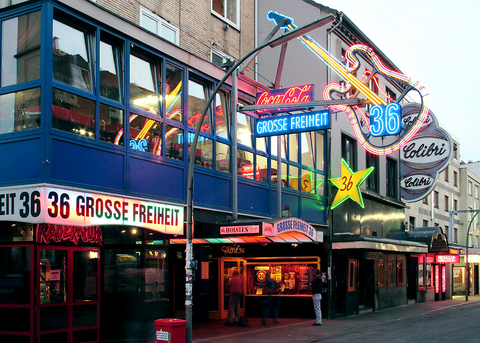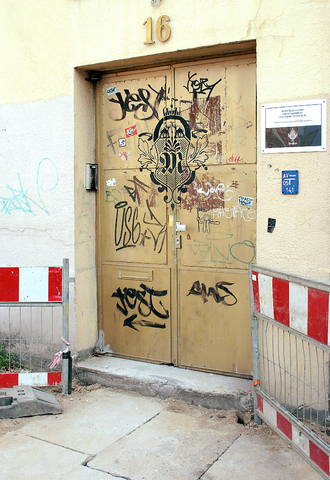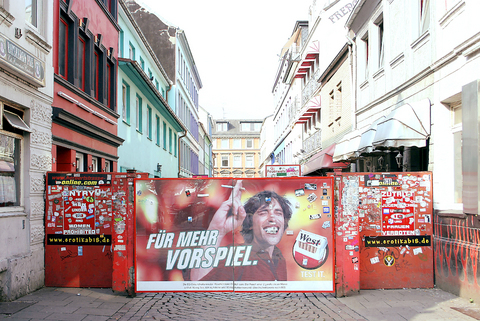It's a typical early evening scene in Hamburg. Several well-dressed diners are discussing their most recent vacations while sampling the "new German" cuisine at Schauermann, a chic new harborside restaurant on Hafenstrasse in the St. Pauli area, all but oblivious to the scene outside the restaurant's large windowed facade: A large banner draped from the roof of a nearby apartment building reads: "Eat the Rich" -- evidence that the spirit of healthy anarchy lives on in St. Pauli, a district that is balancing precariously between prostitutes and squatters and gentrification.
The most famous and heavily
touristed street in St. Pauli is the Reeperbahn, an avenue that defines the heart of the city's red-light district.

PHOTOS: NY TIMES
But rather than intimidate, St. Pauli acts as an exhilarating foil to the beauty and almost sterile perfectionism of Hamburg. A city that's home to the most old-moneyed families in the country. Hamburg is sometimes called the "Venice of Germany" for the various canals running through a mix of imposing restored landmarks and
glittering, modern facades. Regal,
elegant villas line the Elbchaussee.

PHOTOS: NY TIMES NEWS SERVICE
St. Pauli, on the other hand, has always been an outsider. Literally. Centuries ago, the land on which the neighborhood stands was outside the city's protective walls, and was
continuously battered and displaced by battle. The Reeperbahn was once a stretch of land where rope producers used to weave thick cord for the harbor's ships. ("Reeper" translates as ropemaker in an old dialect).
As St. Pauli was engulfed by

Hamburg's growing borders, it became the city's physical center. Now,
exploring the area's blinking and
electric streets, it's as if you've passed through the looking glass into the throbbing secret heart of the city -- and happened upon its most exciting scene. While one still passes by more pornographic-video window displays and East European streetwalkers than groovy DJ lounges, the street houses some of the city's more exclusive night-life venues.
"I had a friend from New York
visiting recently and he fell in love with the club scene here," said Scott McCormack, who moved from Manhattan to Hamburg last year to write a historical novel.
When the party crowd from some of Hamburg's wealthier circles head to St. Pauli, they're frequently found at East, an upscale hotel and restaurant-lounge that opened in a former iron foundry last fall, designed by the
Chicago-based architect Jordan Mozer.
It's not just the colorful design or designer cocktails that make East so fresh, it's that such a place exists just a few minutes' walk from the Reeperbahn. Like the other posh lounges and restaurants sandwiched between the neighborhood's dark car lots and sex shops, the extreme juxtaposition works amazingly well.
One might find that same polished East crowd sweating to electro music at the underground Bar Morphine (open only Friday after midnight), behind a nondescript door on a nearby block. Just a few strides from the renowned Herbertstrasse, a block-long street of bordellos closed off to women and anyone under 18 (enforced by the prostitutes themselves), stylish regulars dine well in the sleek Italian restaurant Cuneo.
At a St. Pauli soccer match last month it was possible to spot locals and heirs alike. But at the stadium (a quick walk from East and the Reeperbahn), the fans converged into what looked like a dancing and cheering band of pirates.
Local residents are less accepting of the big investors who have started to invade the area, obvious from the various construction sites. For the moment, the hope is that the Spielbudenplatz will become a market that would serve as a lively daily commercial hub; while the area around the Reeperbahn is extremely colorful and electric at night, by day it's faded and hung over.
But the neighboring hip Schanzen district, within St. Pauli's northern borders, is usually buzzing by noon. "This is absolutely my favorite part of the city," McCormack said. "It's like the East and West Villages combined."
At the new Eisheiligen on Wohlwillstrasse, a cafe-style ice cream shop, parents with brightly dyed hair and leather jackets exchanged licks of melon and biscuit with their urban offspring. It was a scene that captured a Hamburg that's both relaxed and cutting edge.
Quick guide to Hamburg:
Getting there:
Return ticket to Hamburg from Taipei costs NT$25,300 plus tax (around NT$8,000) with Swissair. Through Interlink Travel (call (02) 2578 0611).
Where to stay:
■ East: Simon-von-Utrecht-Strasse 31, (309 930), www.east-hamburg.de, has 103 modern-styled rooms for US$174 to US$445.
■ Kogge: Bernhard-Nocht-Strasse 59, (312 872); www.kogge-hamburg.com, is a former bordello. Its 12 small rooms have been decorated by local artists: US$57.
■ Schanzenstern: Bartelsstrasse 12, (439 8441), www.schanzenstern.de, is a simple, clean hostel in Schanzen. Rooms go for US$40 to US$100.
Where to eat:
■ Schauermann: Hafenstrasse 136-138, (3179 4660), serves "new German" cuisine with a Mediterranean twist amid coolly
elegant 1960s decor.
■ Artisan: Kampstrasse 27, (4210 2915), is an intimate place serving contemporary
cuisine. Fixed-price dinners are US$40 to US$100, without wine. Closed Sunday and Monday.
■ Zirkus Erich: Erichstrasse 19, (6887 3033), a stylish Mediterranean restaurant at the Erotic Art Museum. A meal for two without wine is about US$45.
■ Cuneo: Davidstrasse 11, (312 580), serves classic Italian entrees, ranging from US$12 to US$26. Closed Sunday.
What to See and do:
■ Erotic Art Museum: Bernhard-Nocht Strasse 69, (317 8410); www.eroticartmuseum.de (German only): With an impressive permanent collection of artwork from Picasso to David Hockney, the museum is now showing an exhibit of fetish art.
■ Kurverwaltung St. Pauli: (3179 0747), ww.kurverwaltungstpauli.de, offers tours of St. Pauli. For an English-speaking guide call ahead and book Kiki, who specializes in the area's architecture and future projects. A more than two-hour-long tour costs US$30 for up to five people.
■ FC St Pauli: A legendary soccer team but now in the third division, plays its games at Millerntor Stadium, in the center of St. Pauli. Tickets are US$10 to US$100.
Note: To call Hamburg, dial 49-40 before for the numbers above.

On April 26, The Lancet published a letter from two doctors at Taichung-based China Medical University Hospital (CMUH) warning that “Taiwan’s Health Care System is on the Brink of Collapse.” The authors said that “Years of policy inaction and mismanagement of resources have led to the National Health Insurance system operating under unsustainable conditions.” The pushback was immediate. Errors in the paper were quickly identified and publicized, to discredit the authors (the hospital apologized). CNA reported that CMUH said the letter described Taiwan in 2021 as having 62 nurses per 10,000 people, when the correct number was 78 nurses per 10,000

As Donald Trump’s executive order in March led to the shuttering of Voice of America (VOA) — the global broadcaster whose roots date back to the fight against Nazi propaganda — he quickly attracted support from figures not used to aligning themselves with any US administration. Trump had ordered the US Agency for Global Media, the federal agency that funds VOA and other groups promoting independent journalism overseas, to be “eliminated to the maximum extent consistent with applicable law.” The decision suddenly halted programming in 49 languages to more than 425 million people. In Moscow, Margarita Simonyan, the hardline editor-in-chief of the

Six weeks before I embarked on a research mission in Kyoto, I was sitting alone at a bar counter in Melbourne. Next to me, a woman was bragging loudly to a friend: She, too, was heading to Kyoto, I quickly discerned. Except her trip was in four months. And she’d just pulled an all-nighter booking restaurant reservations. As I snooped on the conversation, I broke out in a sweat, panicking because I’d yet to secure a single table. Then I remembered: Eating well in Japan is absolutely not something to lose sleep over. It’s true that the best-known institutions book up faster

Though the total area of Penghu isn’t that large, exploring all of it — including its numerous outlying islands — could easily take a couple of weeks. The most remote township accessible by road from Magong City (馬公市) is Siyu (西嶼鄉), and this place alone deserves at least two days to fully appreciate. Whether it’s beaches, architecture, museums, snacks, sunrises or sunsets that attract you, Siyu has something for everyone. Though only 5km from Magong by sea, no ferry service currently exists and it must be reached by a long circuitous route around the main island of Penghu, with the